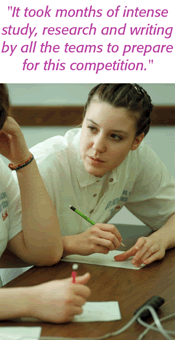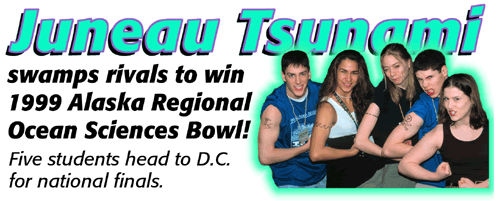
SEWARD, ALASKA, March 1999—Five energetic students from Juneau-Douglas High School--calling themselves "Tsunami"--fought off fierce competition to take first place in the Alaska regional competition of the National Ocean Sciences Bowl (NOSB).
 |
| Diana Richmond of East Anchorage High School carefully listens to other teammates during a question during the morning round-robin competition. |
Juneau's Tsunami team defeated nine other Alaska high school teams in competition February 27-28 in Seward. The event included presenting a research paper on the decline of Steller sea lions and a Jeopardy-style ocean knowledge quiz that pitted teams against one another.
Students from Anchorage's Dimond High School won the quiz portion of the competition, but the overall win went to Juneau's Tsunami students because of their first place finish in the research paper presentation and second place standing in the quiz. Dimond took fifth place in the research presentation.
"I'm really proud of all these kids," said NOSB organizer Judy McDonald. "It took months of intense study, research and writing by all the teams to prepare for this competition."
The five students of Tsunami won tuition waivers for their first year of college at the University of Alaska Fairbanks. They also will travel to Washington, D.C. April 10-12 to compete against teams from 17 other states in the finals of the National Ocean Sciences Bowl. Winners of the national competition will be invited to participate in the Secretary of the Navy's Engineering and Science Residential Program, a six-week secondary science camp in Mississippi They'll also receive a $1,000 stipend and 3 undergraduate credits. The National Ocean Sciences Bowl is sponsored by CORE, the Consortium for Oceanographic Research & Education. Core is a national organization of ocean research agencies and institutions. The Alaska regional competition is sponsored by the University of Alaska Fairbanks School of Fisheries and Ocean Sciences and the Alaska Sea Grant College Program.
The goal of the competition is to recognize and reward excellence among students interested in ocean studies and to encourage them to join the next generation of oceanographers and marine scientists. The bowl also aims to broaden awareness of the critical value of ocean research among high school students, educators, parents and the public.
Ten teams from eight Alaska high schools entered the Alaska regional competition. Chugiak High School led the field going into the single elimination tournament. Also making it into the elimination rounds were Juneau, Seward, Anchorage's Dimond, Soldotna's Skyview, White Mountain and last year's defending state champion, East Anchorage High School.
In a major upset, eighth-ranked White Mountain, a small rural high school in western Alaska, out-dueled its much larger rival, Chugiak.
 |
| Juneau-Douglas High School Tsunami Team members Luke Fanning and Sommers Cole demonstrate what concentration is all about. |
Then it was Anchorage's East matched against cross-town Dimond, where Dimond came out on top. Juneau's Tsunami won against White Mountain in the second round of single-elimination play.
Going into the final round, first-ranked Tsunami met their match, with Dimond scoring 78 points against Juneau's 34 points. In the final round, Dimond squared off against the Tsunami team to determine first and second place, while Anchorage East played White Mountain for the remaining slots. The final bowl results were: Dimond first, Juneau's Tsunami team second, and East third.
In addition to the fever pitch of the science competition, other high
school students participated in the first NOSB Art Show, organized to
showcase creative depictions of marine-related topics. The event was held
at and sponsored by the Alaska SeaLife Center. Brian Lo of Seward High
School won Best of Show and a digital camera for his school's art department.
The camera was donated by the Alaska Sea Grant College Program.
FINAL STANDINGS
Overall Competition 1st Place: Juneau-Douglas High School Tsunami Team
with coach Clay Good, Kanani Pavitt, Sommers Cole, Colleen Dilts, Luke
Fanning, Tawnya Durand. Each member won first year free tuition at the
University of Alaska Fairbanks.
2nd Place: East Anchorage High School with coach Danelle Van Holstyn Jamie
Bourgeios, Jeana Hilbish, Diana Richmond, Beth Poland. Team won $300 for
their high school's science department.
3rd Place: Anchorage's Dimond High School with coach Elizabeth Larman,
Adam Yeager, Kevin Fox, Alicia Brantley, Ashley Faciane, Jamie Everett.
Dimond also won the Mayor's Cup for most points scored in a single round;
142 points. Team won $200 for their high school's science department.
Written Project and Presentation:
1st Place: Juneau-Douglas High School. Winners received $100 scholarships
for each team member sponsored by Kodiak fisherman Bill Jacobson. Juneau
High School's science department received $1,000 donated by the Alaska
Sea Grant College Program.
2nd Place: East Anchorage High School
3nd Place:: Juneau High School
4th Place: Chugiak High School
5th Place: Anchorage's Dimond High School
Art Show Winners
Best of Show: Brian Lo, Seward High School
Painting:
1st, Chelsea Woelkers, Seward High School
2nd , Travis Hiner, Skyview High School
3rd, Ruth Banse, Seward High School
Honorable Mention: Tiffany Brand of Seward High School & Noelle Verba
of Skyview High School in Soldotna.
Drawing:
1st, Chelsea Woelkers, Seward High School
2nd, Marion Glaser, Seward High School
3rd, Keegan Marrs, Seward High School
Mixed Media:
1st, Jason Tibbitts, Skyview High School
2nd, Jamie Gruel, Skyview High School
Sculpture:
1st, Wes Shafer, Seward High School
2nd, Jordan Houghton, Seward High School
3rd, Patty Ilog, Seward High School
Honorable Mention: Blassi Shoogukwruk, White Mountain School
Many sponsors made this event possible. Coeur Alaska donated the travel
costs for both Juneau teams. Alaska Airlines made it possible for the
White Mountain team to attend the competition. UAF, with its Sea Grant
College Program, Marine Advisory Program, School of Fisheries and Ocean
Sciences, and Seward Marine Center, provided judges, logistics, organization
and funding support. The Alaska SeaLife Center and the Seward High School
donated the use of their facilities. Awards made to the science departments
of Anchorage East and Dimond High Schools were donated by the faculty,
staff and students of UAF's School of Fisheries and Ocean Sciences.
The National Marine Fisheries Service-Juneau provided enough funds to
have specially designed T-shirts made up for all the participants. MAP
and KAKM 7 folks video taped the entire event, so that it could be broadcast
at a later date throughout the state on PBS stations. About 50 Seward
and science community volunteers made it all happen.
How
It Works
The National Ocean Sciences Bowl consists of a round-robin/double-elimination
format for teams of high school students. Teams consist of four students
plus one alternate and a coach. The format involves a timed competition
(defined as the use of "lock-out"-type buzzer systems and clocks) between
two teams, using multiple-choice or short-answer questions within the
broad category of the oceans. Questions are drawn from the scientific
and technical disciplines used in studying the oceans (physics, chemistry,
geology, atmospheric science, biology, etc.) as well as from topics
on the contributions of the oceans to national and international economics,
history and culture.
Each match consists of a series of these multiple-choice toss-up questions. A team that correctly responds to a toss-up question is given a bonus multiple-choice or short-answer question. The match consists of two 8-minute halves with a 2-minute break. Each match has a maximum of 25 toss-up questions and an equal number of bonus questions.
In Alaska, coordinators have added a second component to the ocean sciences bowl: an ocean science research project, which counts for 50 percent of the total score. Students must develop a research document on a specific ocean-related question or problem. For NOSB 2000, the research project requires students to discuss the future of salmon populations and fisheries in Alaska, and to prepare a long-term management plan for the salmon resources closest to their school, considering both scientific and socioeconomic factors. The students must also give an oral presentation on their project. The written and oral presentations each count for half of the 50 percent total.
Although it does not count toward winning points, the Alaska regional competition includes a juried art show in which students are invited to submit artwork in two-dimensional, three-dimensional and mixed media. Artwork must be original and must have an ocean theme.
